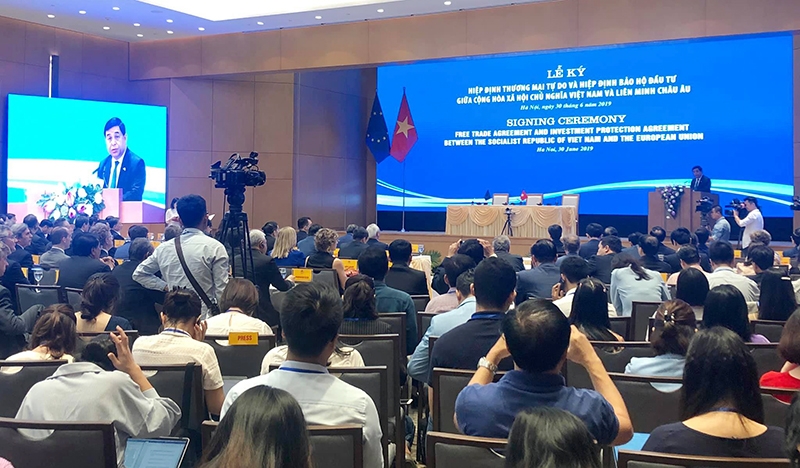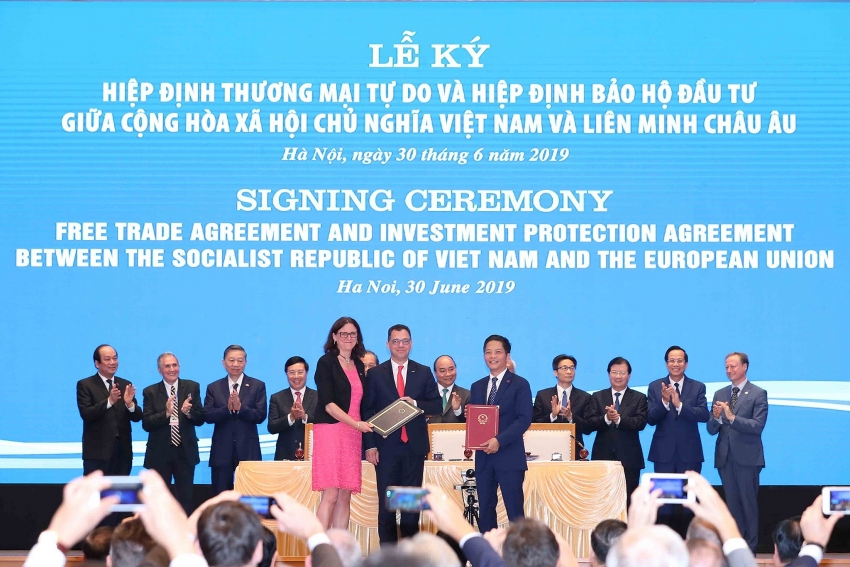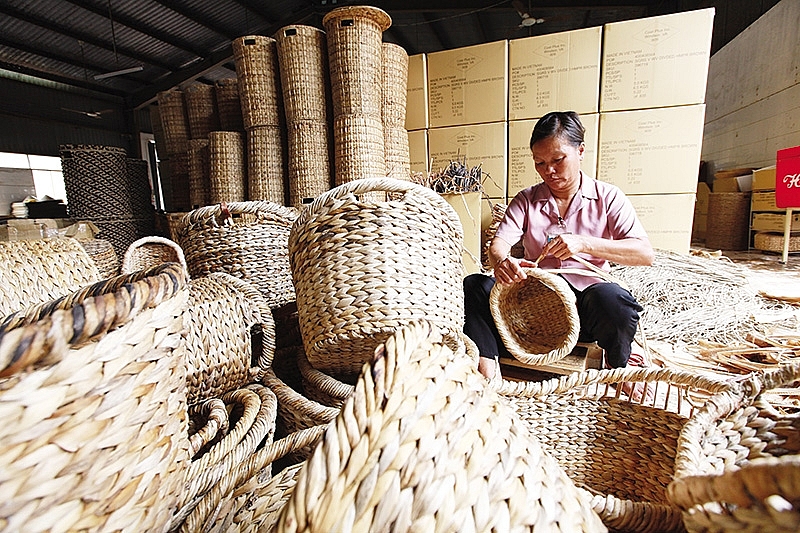Landmark day arrives as EVFTA and IPA inked
 |
| Landmark day arrives as EVFTA and IPA inked, photo MPI Facebook |
Today, June 30, 2019 will be remembered as a major milestone in the bilateral relationship between Vietnam and the European Union, as EU Commissioner for Trade Cecilia Malmström and Romanian Minister for Business, Trade and Entrepreneurship Ștefan-Radu Oprea flew to Vietnam to sign the EU-Vietnam Free Trade Agreement (EVFTA) and the Investment Protection Agreement (IPA) on the bloc’s behalf in Hanoi.
The agreements are set to bring unprecedented benefits for both European and Vietnamese companies, consumers, and workers, while promoting respect for labour rights, environmental protection, and the fight against climate change under the Paris Agreement on Climate Change.
President of the European Commission (EC) Jean-Claude Juncker said, “I welcome the decision taken today by EU members. After Singapore, the agreements with Vietnam are the second to have been concluded between the EU and a Southeast Asian country, and represent stepping stones to a greater engagement between Europe and the region. It is also a political statement by two partners and friends standing together for open, fair, and rules-based trade.”
Commissioner for Trade Malmström also said, “I am very pleased to see that member states have given a green light to our trade and investment agreements with Vietnam. Vietnam is a vibrant and promising market of more than 95 million consumers, and both sides have much to gain from stronger trade relations. Beyond the clear economic benefits, this deal also aims to strengthen respect for human rights as well as protecting the environment and workers’ rights.”
According to the EC, the EVFTA will eliminate nearly all customs duties on goods traded between the two sides in a progressive way that fully respects Vietnam’s development needs. The agreement also contains specific provisions to remove technical obstacles, such as those in the automobile sector, and will ensure that 169 traditional European food and drink products recognised as geographical indications are protected in Vietnam.
Thanks to the agreement, EU companies will also be able to participate in bids for procurement tenders in Vietnam on an equal footing with domestic companies.
Meanwhile, the IPA includes modern rules on investment protection enforceable through the new investment court system and ensures that the right of the governments on both sides to regulate in the interest of their citizens is preserved. It will replace the bilateral investment agreements that 21 EU member states currently have in place with Vietnam, putting in place new legal guarantees preventing conflict of interest and increasing transparency.
After being signed, the agreements will be presented to the European Parliament for consent. Once the parliament has given its consent, the EVFTA can be officially concluded by the European Council and entered into force, while the IPA will first need to be ratified by member states according to their respective internal procedures.
The EU and Vietnam officially launched negotiations for the EVFTA in 2012 and finished negotiating the deal in Brussels in December 2015 after 14 rounds of negotiations. In July last year, both sides concluded the IPA.
 |
 |
Wider doors
According to the EU Delegation to Vietnam, the country is the EU’s second-largest trading partner in the Southeast Asian region after Singapore, with trade worth €49.3 billion ($56.15 billion) for goods and over €3 billion ($3.42 billion) for services.
The EU is one of the most important sources of foreign investment for Vietnam. Investors from 23 out of 28 EU member states have registered more than $24 billion into nearly 2,200 projects over the course of the past 28 years. An increasing number of companies are establishing themselves in Vietnam to set up hubs and boost exports.
Chula Fashion, a small, family-owned clothing company established in 2007 in Hanoi with 68 employees, is one such business.
“The EVFTA would make it easier for us to expand into European markets. With the agreement in place, we’ll be able to start thinking about using more European fabric in the clothes we make, as well as opening more stores in Europe,” said Laura Fontan and Diego Cortizas, owners of Chula Fashion.
The new rules of origin in the EVFTA will make it easier for Chula to export to the EU. The deal will also remove Vietnamese tariffs of 7.5 per cent on EU textiles as soon as it takes effect. This will enable Chula to use high-end European cotton and linen in addition to the textiles it sources from Asia.
Elsewhere, Swedish glove-maker Hestra said the EVFTA will give EU businesses such as itself a helping hand.
“With the EVFTA in place, we would look to invest in a new factory in Vietnam with 200-400 employees alongside our current factory. This would not only be a good opportunity for our company, but also create more job opportunities for the local community,” said Hestra owners and brothers Claes and Svante Magnusson.
Hestra, which exports its gloves to over 30 countries worldwide, will benefit from the removal of EU tariffs on gloves of up to 9 per cent. This will make it easier for Hestra to export its products to the EU.
Alongside that, the agreement’s new rules of origin will make it easier to trade products tariff-free when they include inputs from other countries the EU has trade agreements with. This will benefit textile producers, as well as companies like Hestra.
The company exports textiles and wool from the EU to its factory in Vietnam, where it makes its gloves. With the trade agreement, these gloves can then be shipped to the EU tariff-free.
 |
| The EVFTA will, over time, help remove customs duties on goods Photo: Le Toan |
Increased confidence
According to new research released by the European Chamber of Commerce in Vietnam (EuroCham), nearly 80 per cent of European companies surveyed believed that the EVFTA will have either a ‘significant’ or ‘moderate’ impact on their business in the medium term. Meanwhile, over 80 per cent believed that the EVFTA will make Vietnam more competitive, while 72 per cent said that it will help the country to become a hub for European business in the ASEAN region.
“Meanwhile, 80 per cent of EuroCham members believe the EVFTA will improve Vietnam’s competitiveness compared to other countries such as China, Japan, and South Korea,” said Nicolas Audier, chairman of EuroCham.
Pham Thai Lai, president and CEO of Siemens Vietnam told VIR that the EVFTA is a great foundation to further boost trade, attract more investment, create more jobs, and to foster sustainable development between the EU and Vietnam.
“I strongly believe that we can expect robust investment growth from the EU to Vietnam and a substantial increase in exports from Vietnam to the EU as a result of the removal of over 99 per cent of tariffs on goods traded between the two,” Lai said.
Furthermore, he said, Vietnam’s commitment to ensure a more open and transparent business environment will help to increase the investment flow from high-valued projects of the EU in Vietnam. This will enable Vietnam to become a hub for trade and investment activities of the EU in the Southeast Asia. “The increase in value chains and value-added services will support the country in restructuring its economic growth model and will be a key driver for Vietnam’s ambition to become an industrialised nation in the near future.”
According to the General Statistics Office, last year the EU constituted one of the most important overseas markets for Vietnam. The EU purchased 17 per cent of the country’s global exports in 2018, and two-way trade expanded to $56.3 billion mainly owing to the impressive growth rate of Vietnam’s exports to the EU, which made an on-year increase of 11 per cent ($42.5 billion). In the first six months of this year the figure hit $23 billion, of which $11.6 billion was a surplus for Vietnam.
Main EU imports from Vietnam include telecommunications equipment, footwear and textiles, furniture, and agricultural products. The EU mainly exports to Vietnam goods such as machinery and transport equipment, chemicals, and food and beverages.
| Content of the EVFTA The European Commission has described the EVFTA as the most ambitious free trade deal ever concluded with a developing country, and features the following: - Near complete removal of tariff barriers: elimination of over 99 per cent of customs duties on exports in both directions; - Reduction of non-tariff barriers: Vietnam will align more closely with international standards on motor vehicles and pharmaceuticals. As a result, EU products (which already comply with these standards) will not require additional Vietnamese testing and certification procedures. Vietnam will also simplify and standardise customs procedures; - EU access to Vietnamese public procurement: EU companies will be able to compete for Vietnamese government contracts, and vice-versa; - Improved access to Vietnamese service markets: the FTA will make it easier for EU companies to operate in the Vietnamese postal, banking, insurance, environmental, and other service sectors; - Investment access and protection: Vietnamese manufacturing sectors such as food, tyres, and construction materials will open up to EU investment. The EVFTA establishes an investor-state tribunal to resolve disputes between EU investors and Vietnamese authorities, and vice-versa; and - Promoting sustainable development: the EVFTA includes commitments to implement International Labour Organization core standards (for instance, on freedom to join independent trade unions – potentially a momentous change as Vietnam does not at present have any such unions) and UN conventions (for instance, on combating climate change and protecting biodiversity). |
| The EVFTA will remove tariffs on a range of key EU export products - Almost all machinery and appliances will be fully tariff-free at entry into force, with the rest after seven years. Current duties are 35 per cent; - Motorcycles with engines larger than 150 cubic centimetres will see tariffs fully removed after seven years (current duty is 75 per cent) and cars after 10 years (down from 78 per cent); - Car parts will be duty free after seven years (current duties are 32 per cent); - Roughly half of EU pharmaceuticals exports will be duty free at entry into force and the rest after seven years (currently facing duties of 8 per cent); - All textile fabric exports will see their duties removed at entry into force (currently with a tariff of 12 per cent); - Nearly 70 per cent of EU chemicals exports will be duty free at entry into force (current duties up to 5 per cent) and the rest after three, five or seven years (current tariffs of 25 per cent); - Wines and spirits will be fully tariff-free after seven years (down from tariffs of 50 and 48 per cent respectively); - Frozen pork meat will be duty free after seven years, beef after three years, dairy products after a maximum of five years, and food preparations after a maximum of seven years; - Tariffs on chicken will be progressively reduced to zero in the next 10 years; and - For sensitive agricultural products, the EU will not open its market up to Vietnamese imports completely. Quotas will limit the quantity that can enter the EU duty-free. This includes rice, sweetcorn, garlic, mushrooms, eggs, sugar and high-sugar products, manioc starch and other modified starches, ethanol, surimi, and canned tuna. |
What the stars mean:
★ Poor ★ ★ Promising ★★★ Good ★★★★ Very good ★★★★★ Exceptional
Themes: EVFTA & EVIPA
Related Contents
Latest News
More News
- Two national hospitals expand capacity with new facilities (December 20, 2025 | 09:00)
- Ha Tinh breaks ground on major Vingroup industrial and energy projects (December 19, 2025 | 18:24)
- EVN launches major power infrastructure projects nationwide (December 19, 2025 | 18:17)
- VAL inaugurates second production line to meet domestic animal feed demand (December 19, 2025 | 16:37)
- Sun Group pioneers urban tram system in Phu Quoc (December 19, 2025 | 15:00)
- Seven major projects launched to drive Hanoi’s next growth phase (December 19, 2025 | 14:00)
- Securing capital and efficiency for Vietnam’s 2026-2030 growth ambitions (December 17, 2025 | 10:00)
- Vietnam bucking trend in the global M&A landscape (December 16, 2025 | 14:20)
- HDS Summit spotlights Vietnam’s rising role in regional supply chains (December 16, 2025 | 08:00)
- Kolon signs $48 million airbag supply deal with Autoliv (December 15, 2025 | 18:14)

 Tag:
Tag:






















 Mobile Version
Mobile Version